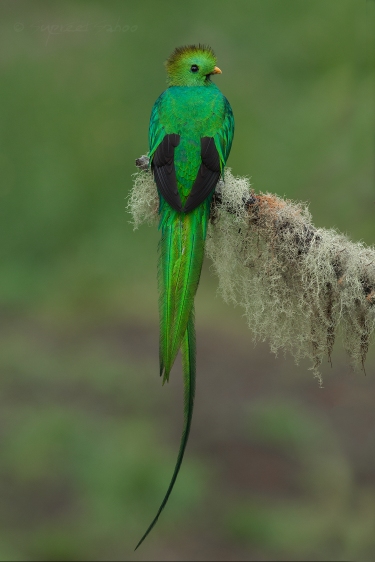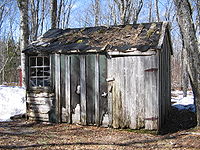Resplendent Quetzals, Pharomachrus mocinno (Trogoniformes: Trogonidae) are highly excellent birds. The males are a bright, iridescent green, with tails about twice the length of their body. The females, however, look like pretty typical trogons — dull front, green back, black-and-white striped tail. Ohai sexual selection.
Resplendent Quetzals are found in cloud forests throughout Central America, from NW Panama stretching over to Oaxaca and Chiapas, Mexico. I’ve seen one, a male, outside of Boquete, Panama.
 Resplendent Quetzal (image by Supreet Sahoo, via Wikipedia).
Resplendent Quetzal (image by Supreet Sahoo, via Wikipedia).
The word “quetzal” comes into English via Spanish from the Nahuatl quetzalli, meaning a quetzal feather. The Nahuatl word for a quetzal itself is quetzaltototl (“tototl” meaning “bird”).
Other English words that come via Spanish from Nahuatl (sometimes known as “the language of the Aztecs”, but spoken by around 1.5 million people today) include avocado (from āhuacatl, “testicle”), cocoa, chili, chipotle, coyote, guacamole, hoatzin (the bird), ocelot, taco, tomato, and shack (from xacalli, “a wooden hut”).
 I had never before thought about the origin of the word “shack”, but the OED backs up Wikipedia on this: it’s probably Nahuatl. For the curious, “shackle” comes from the Old English sceacul and has cognates throughout the Germanic languages.
I had never before thought about the origin of the word “shack”, but the OED backs up Wikipedia on this: it’s probably Nahuatl. For the curious, “shackle” comes from the Old English sceacul and has cognates throughout the Germanic languages.
In contrast, the word “resplendent” is much more boring: it comes from the Latin resplendent, same meaning, with cognates in Old French, Old Occitan, Catalan, Italian, etc.
 This is what comes up when you Google “resplendent.” It’s certainly very lovely? Image by Gaëtan Bourque.
This is what comes up when you Google “resplendent.” It’s certainly very lovely? Image by Gaëtan Bourque.
I must confess to being originally perplexed by the genus name, Pharomachrus. The Handbook of the Birds of the World translates it as Greek for “long cloak” (φάρος pharos + μακρος macros). I’m totally with them on macros for some synonym of “big” — macroecology, macroevolution, macrophage, macroscopic, macrobiotic — but I’m confused about pharos. φάρος means “lighthouse,” or any sort of beacon. It’s where we get Latin pharus, French phare, Spanish and Italian faro, etc. It comes from the island of the same name, off the coast of Alexandria, upon which there was…a lighthouse. I’m finding lots of potential Greek words for cloak, such as μανδύας, but none of them look anything like pharos.
The OED does have an entry for the English word “pharos”, though, meaning “a cloak”, and claims that this word is from the Greek ϕάρος , so who am I to argue.
 This is Benedict Cumberbatch as Stephen Strange. He has a very long cloak (the “cloak of levitation,” not that I’m a Marvel fan or anything). He is not a lighthouse.
This is Benedict Cumberbatch as Stephen Strange. He has a very long cloak (the “cloak of levitation,” not that I’m a Marvel fan or anything). He is not a lighthouse.
Anyway, the species name is very easy: mocinno comes from José Mariano Mociño, a naturalist from “New Spain” (now Mexico), who was the first to classify the Resplendent Quetzal.
The Trogonidae are the 39 species that make up the sole family in the order Trogoniformes, tropical things with short necks and heterodactyl toes. (Meaning digits 1 and 2 point backward and digits 3 and 4 point forward. They’re the only animals that do this. Most birds are anisodactyl, meaning that digit 1 is backwards and the rest forwards. Think about how you’d grip the monkey bars, then pretend your pinkie isn’t there — that’s anisodactyl.)
Anyway, the word “trogon” comes from the Greek τρώγων (trogon) meaning “to gnaw”, referring to the fact that trogons use their beaks to excavate their own nests in trees.
 You can gnaw on trees to build yourself a nest…or you can gnaw on cookies. Om nom cookies.
You can gnaw on trees to build yourself a nest…or you can gnaw on cookies. Om nom cookies.